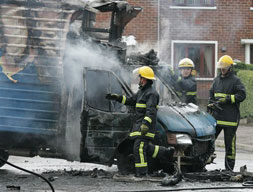| Read more about gangs and youth violence in: | THE AMERICAS | ASIA | AFRICA | EUROPE |

Firemen extinguish a truck set on fire by gangs during rioting in September 2005. Credit: AP Photo/Peter Morrison |
Northern Ireland: Youth Violence in the Wake of a Cease-fire
A new breed of crime and violence has emerged in the streets of Northern Ireland since the end of The Troubles, the infamous period of violent conflict between Catholics and Protestants.
The Troubles began with the civil rights marches of the 1960s and lasted until the Good Friday Agreement of 1998, killing more than 3,000 people — mostly civilians. Since the cease fire of 1994, there has been a steady reduction in violence, although public unrest associated with paramilitary activity has not stopped entirely. In September 2005, for instance, riots broke out when police prevented the Orange Order, the largest Protestant organization in Northern Ireland, from marching near a hard-line Catholic area of Belfast. Fifty police officers were injured.
Meanwhile, among the youth there has been an increase in what has been described as antisocial, as opposed to politically motivated, violence. Much of the violence takes place within “interface” communities — Catholic communities that border Protestant ones or Protestant communities that border Catholic ones — that are usually separated by a wall. Yet the young people involved don’t seem to have formal connections to any of the paramilitary groups, nor do they have any strong political allegiances or formal connections to mainstream political organizations.
This is a departure from previous street violence among Northern Ireland’s youth. Although not organized into structured gangs, today’s delinquents come from both sides of the political conflict and are motivated primarily by territorial disputes and boredom. Former outlets for such tensions have disappeared with the supposed resolution of the sectarian conflict. With its increased political legitimacy, for instance, Sinn Féin, the political wing of the Irish Republican Army, now attracts focused and articulate self-starters rather than the disaffected and marginalized youth. Alcoholism, inadequate education, a lack of policing, the easy availability of drugs, and a local tradition of street conflict have not disappeared. At the same time, new tensions have materialized. An influx of foreign workers arriving in the wake of the cease fire has led to an intensification of hate crime, including threats, racist graffiti, and beatings of recent immigrants. At this point, most young people do not have guns, which are tightly controlled by the paramilitary groups, but rely instead on knives, petrol bombs/Molotov cocktails, blast bombs, metal bolts and other heavy missiles fired from catapults, and only occasionally firearms.
